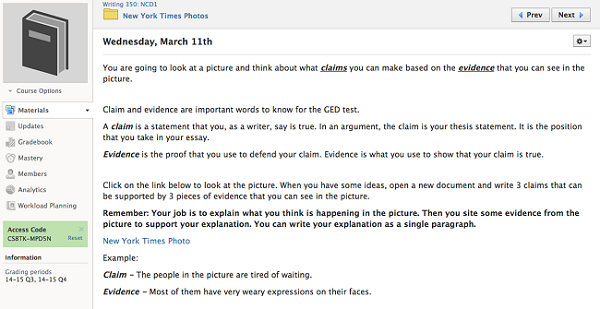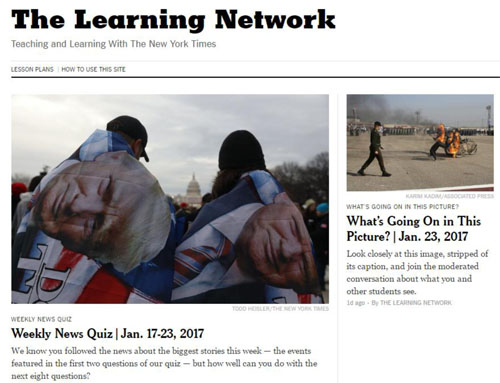- MN ABE Connect
- Archive
- Boosting Critical Thinking Skills with the New York Times Learning Network
Boosting Critical Thinking Skills with the New York Times Learning Network
Stephanie Sommers, ACES CoordinatorBy now word is getting out about the key shifts defined in CCRS for English Language Arts (ELA). These three shifts are:
- Regular practice with complex text and its academic language
- Reading, writing and speaking grounded in evidence
- Building knowledge through content-rich language
In order to successfully make these shifts in our ABE classrooms, we need to be intentionally integrating critical thinking skills into our lessons on a regular basis. As outlined in the Critical Thinking section of the Transitions Integration Framework (TIF), these skills include being able to organize, analyze and illustrate relationships between components, items and ideas, and using information to draw conclusions and make decisions.
 There are a variety of high-quality websites that provide instructors with informational texts and question sets. Few of these sites, however, can rival the variety of content and depth of complexity that is found on the New York Times Learning Network website (nytimes.com/section/learning). For this reason, it is the newest addition to the Critical Thinking section of the ACES resource library.
There are a variety of high-quality websites that provide instructors with informational texts and question sets. Few of these sites, however, can rival the variety of content and depth of complexity that is found on the New York Times Learning Network website (nytimes.com/section/learning). For this reason, it is the newest addition to the Critical Thinking section of the ACES resource library.
Among the many things that I love about The Learning Network website are its limited number of ads and the fact that you don’t need to create any sort of user account in order to access the content. However, without subscribing there is a limit to the number of articles and lesson plans that one can view for free each month. The website was created in order to support instructors who want to use the New York Times newspaper as a teaching tool.
What’s Going On in This Picture?
I was first introduced to the website a few years ago when a colleague and I started using the What’s Going On in This Picture? feature with our reading and writing students. Every Monday The Learning Network posts a picture from the NYT photo archives without its caption. Then, on Thursday of that same week, they post more information about the photo and invite students to reflect on how reading a caption and learning a photo’s backstory helps you to see the image differently.

As a writing teacher, I would link the photo to a weekly discussion post in Schoology (see screenshot above) and have my students describe or explain what they thought was happening in the picture. They would also have to include two pieces of evidence from the photo to support their explanations. Later, my reading teacher colleague would show students the caption and the backstory and they would engage in activities like evaluating the validity of the evidence that the learners had used to write their explanations.
Resources for Students and Instructors
Besides What’s Going On in This Picture?, the Learning Network has a variety of other activities for students and an extensive selection of lesson plans for instructors.

- For students, there is an Article of the Day complete with before reading questions and questions for comprehension and analysis. These articles can be printed or read online for a variety of practice.
- For instructors, there are lesson plans in various content areas, including English Language Arts, Social Studies, and Science & Math. A quick glance at the ELA lesson plans shows lessons to help students do text-to-text comparisons with downloadable materials, such as a graphic organizer for comparing two or more texts, a double-entry chart for close reading, and document analysis questions.
It’s worth visiting the website for these excellent resources alone as they can be printed and used with any text.
First published 1/24/17
Newsletter Signup
Get MN ABE Connect—the official source for ABE events, activities, and resources!
Sign UpArticle Categories
- ABE Foundations/Staff Onboarding
- ACES/Transitions
- Adult Career Pathways
- Assessment
- CCR Standards
- Citizenship
- COVID-19
- Cultural Competency
- Digital Literacy/Northstar
- Disabilities
- Distance Learning/Education
- ELA
- Equity/Inclusion
- ESL
- HSE/Adult Diploma
- Listening
- Math/Numeracy
- Mental Health
- Minnesota ABE
- One-Room Schoolhouse/Multilevel
- Professional Development
- Program Management
- Reading
- Remote Instruction
- Science
- Social Studies
- Speaking/Conversation
- Support Services
- Teaching Strategies
- Technology
- Uncategorized
- Volunteers/Tutors
- Writing